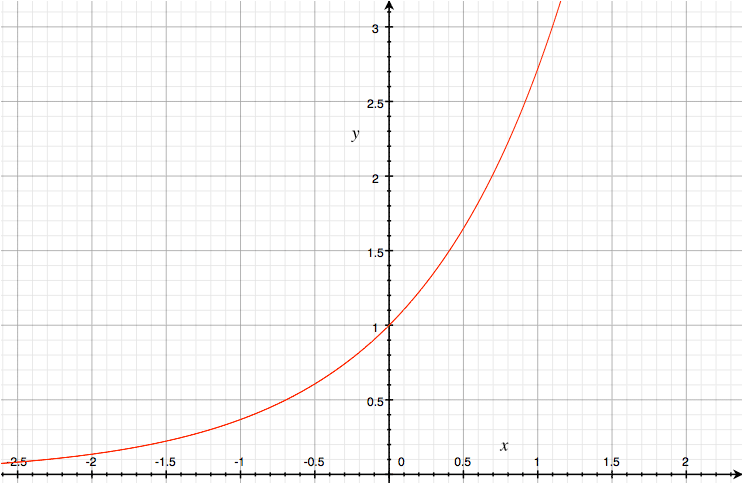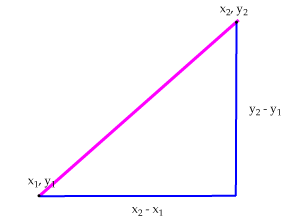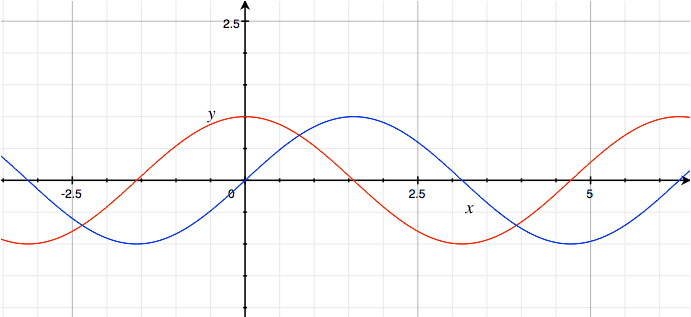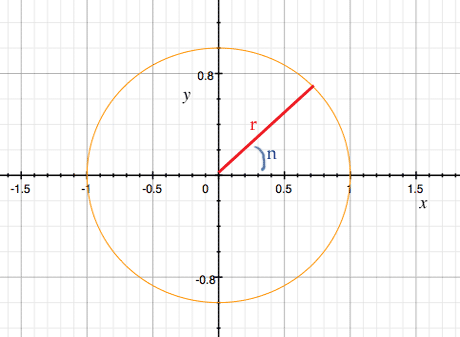
So I thought I’d tell you about it. You can read Feynman yourself, of course— it’s chapter 22— but he was talking to college physics students, and I’m not going to assume you know anything more than high school math. Plus it’s no longer 1963, so I’ll assume you have a calculator, or access to Wolfram Alpha.
2.718281828459045235360287471352662497757247093699959574966967...You’ll probably remember e as the base of natural logarithms. But before we get to logarithms, e has some remarkable characteristics.
To see one of them, let’s look at the function y = ex.


Note: We’re going to be seeing a lot of irrational numbers here. If you see ≅ (approximately equal), that’s a reminder that I’ve truncated the number, which really goes on forever.
So the slope is
(2.7185537 - 2.7182818) / (1.0001 - 1) ≅ 2.718417747Which is close to e. Let’s try a better approximation of the slope, by choosing x2, y2 closer to 1:
(e1.000001 - e1)/ .000001 ≅ 2.718283188Which is even closer to e. It’s beginning to look like the slope at e1 is e1, and in fact it is. You can verify all of these at Wolfram Alpha; e.g. copy and paste ((e^1.000001) - (e^1))/.000001. See what happens if you use closer and closer points.
Let’s try e0, whose value is 1.
(e0.000001 - e0)/.000001 ≅ 1.000000500How about e2 ≅ 7.3890560989?
(e2.000001 - e2)/.000001 ≅ 7.389059793How about eπ ≅ 23.14069263?
(eπ+.000001-eπ)/.000001 ≅ 23.140704203As these examples suggest, the slope of ex at any point is ex. That is, the derivative of ex is itself.
d/dx ex = exThis is the only function of x whose derivative is itself. That makes ex very nice to work with in calculus— we’ll get back to that later.
You have a dollar in an account that pays 100% interest in one year; after the year you’ll have $2.
Suppose it’s 50% every 6 months, instead. Now you get $1 × 1.5 × 1.5 = $2.25.
If there are n intervals, the interest is 100%/n... that is, 1/n. Plus you keep the principal, so you have 1 + 1/n. E.g. for one month it’s 1 + 1/12 = 108.33% and after the year you have
(1 + 1/12)12 ≅ 2.61303529
Compounding daily, at 0.2739726%, gives us
(1+(1/365))365 ≅ 2.714567482That’s starting to look like e, and if we keep making smaller and smaller divisions, that’s exactly where we end up.
We use logarithmic scales all the time; they’re great for reducing enormous ranges of huge numbers to easy-to-grasp small numbers. Some common examples:
Since we normally use base 10, base 10 logarithms are particularly easy.
3.14159265Not difficult, but tedious and error-prone. But we can take advantage of the fact that
×2.7182818
-----------------
2513274120
3141592650
251327412000
629318530000
25132741200000
31415926500000
2199114855000000
6293185300000000
-----------------
8.539734123508770
log ac = log a + log cWe can look up the logs in a table... tables to 14 decimal places have been available since 1620.
log10 3.14159265 ≅ .497149872Now we can use the same table to find out what number this is the log of, which turns out to be ≅ 8.53973412.
log10 2.7182818 ≅ .434294477
sum ≅ .93144434955
Of course, these days we do nothing of the sort— we just use a calculator. But it was a huge time saver until the computer was invented.
(Some of you retro-geeks may say "No, no, people used slide rules." What do you think a slide rule is? Among other things, it’s a couple of logarithmic scales.)
If you’re thinking "Oooh, the limit of e1/n is 1", that’s correct, but that’s not the weird trick. The trick is that a good guess for e1/n is 1 + 1/n, and it’s an increasingly good guess as n gets huge.
1/n e1/n 1 + 1/n 1 2.7182818 2 1/2 1.648721271 1.5 1/4 1.2840254 1.25 1/8 1.133148453 1.125 1/16 1.06449446 1.0625 1/32 1.0317434075 1.03125 1/64 1.015747709 1.015625 1/128 1.007843097 1.0078125 1/256 1.003913889 1.00390625 1/512 1.00195503 1.001953125 1/1024 1.000977039 1.0009765625 1/2048 1.000488400 1.00048828125
We’ll use this trick in a clever way in a moment, but I’ll also point out two things.
All of which means that a function like y = eix should be fine. Now, we can understand raising a number to a power n as multiplying it by itself n times. This is stretched by such ideas as raising it to a fraction or a negative number, and seems almost to break if the number is imaginary. But the algebra all works, so we’ll let the meaning take care of itself.
Still, how do we evaluate an expression like eix? Where do we even start?
We actually have a place to start— the observation from the last section that a good guess at ei/n is 1 + 1/n. Let’s assume that it’s true for complex numbers as well.
Let’s set n to 1024. That is, a good guess for ei/1024 is 1 + i/n = 1 + i/1024. That of course is the complex number 1 + .0009765625i.
That gives us one exponential of an imaginary number. (Or rather, an approximation; the actual value ≅ .999999523 + 0.00097656234i.
Given one value of eix, here are ways to get more; here’s one. Let’s try for i/512. We could use the 1 + 1/n trick, but it gets less accurate as 1/n gets bigger. Instead, let’s take
ei/1024 = 1 + .0009765625iand square both sides. Now, (ab)c is always abc, so
(ei/1024)2 = e(i/1024)×2 = ei/512For the other side, the general rule for complex numbers is
(a × bi)2 = (a × bi)(a × bi)Here a = 1 and b = .0009765625, so we get
= a2 + 2abi + b2i2
= (a2 - b2) + 2abi
(1×1 - .0009765625×.0009765625) + 2×1×.0009765625×iLet’s see what ein looks like, as a function. (I’m just going to let Wolfram Alpha calculate it.) Here’s how it goes for several values of n.
= 0.9999990463 + 0.001953125 i
It looks like there’s some patterns here. All the values we’ve seen so far, both for the real part and the imaginary part, live between -1 and 1. Moreover, looking down the real column, we see the value smoothly going down; when it reaches -1, toward the end of our list, it inches back up again. The imaginary column goes up, reaches 1, and then declines.
0 1 .2 0.9800666 + 0.1986693 i .4 0.921061 + 0.389418 i .6 0.825336 + 0.564642 i .8 0.696707 + 0.717356 i 1 0.540302 + 0.841471i 1.2 0.362358 + 0.932039 i 1.4 0.169967 + 0.985450 i 1.6 -0.0291995 + 0.999574 i 1.8 -0.227202 + 0.973848 i 2 -0.416147 + 0.909297 i 2.2 -0.588501 + 0.808496 i 2.4 -0.737394 + 0.675463 i 2.6 -0.856889 + 0.515501 i 2.8 -0.942222 + 0.334988 i 3 -0.989992 + 0.141120 i 3.2 -0.998295 - 0.0583741 i 3.4 -0.966798 - 0.255541 i
ein = x + iyNow, a square root always has two solutions, positive and negative. We usually say that √2 is 1.41421356, but we could equally well use -1.41421356. Likewise, if i is √(-1), so is -i. Replacing i with -i in an equation is called taking the complex conjugate, and it gives you another true equation:
e-in = x - iyNow let’s multiply these equations together:
ein e-in = (x + iy)(x - iy)Simplifying the left side:
ein e-in = ein - in = e0 = 1And the right side:
(x + iy)(x - iy) = x2 +xyi -xyi - i2y2 = x2 + y2So for any complex number x + iy that we found as a value of ein, we know that
x2 + y2 = 1Does this ring any bells yet? That’s the formula for a circle, so circles are involved in this somehow.
Let’s just get a plot of ein. The red line is the real part, the blue line is the imaginary part.

ein = cos n + i sin nThis is the equation Feynman calls the "amazing jewel" of mathematics. We’re just messing around with exponential functions, and we suddenly arrive at the trigonometric functions.
The equation was first published by Leonhard Euler in 1748.
Rather than plotting ein, we can also plot x and y as n varies. We get this graph:

We can’t represent all complex numbers with ein... but we can represent them as rein. That is, an alternative representation of a complex number x + iy is rein.
The problem is that to understand the proofs, you need far more math than is needed just to understand e and sin/cos! Euler himself used the limit expansions of en, of sine, and of cosine... but even though it’s true, it’s not intuitively obvious that cos x is the sum of -n/(2n)! × x2n.
Let’s take another approach, along the lines of "use Wolfram Alpha to evaluate limits for us until we’re satisfied we know where this is going". Above I mentioned that Bernoulli’s definition of e was
Now e = e1, so the general formula is
x can be a complex number, so we can also write
Let’s try a particular value, namely x = π.
For n = 1, this is (1 + iπ/1)1 = 1 + i π.
You can enter (1 + (i*pi)/2)^2 into Wolfram Alpha, and keep going with higher and higher n’s. Wolfram Alpha will helpfully give you a plot of the results. Here’s how it goes:
It looks like the limit is simply -1, and so it is. Wolfram Alpha will even do limits for you— cut and paste lim((1+(i*pi)/n)^n).
But does Euler’s formula
eix = cos x + i sin xwork for x = π? Cos π = -1 and sin π = 0, so yes. π is of course halfway round the unit circle.
Let’s try another number, say π/6, or 30 degrees. Give Wolfram Alpha lim((1+(i*pi/6)/n)^n) and you get ½√3 + ½ i. And this checks out: if you take sin(π/6) you get ½, and cos(π/6) = ½√3.
Now all you have to do is try out every other possible value of x from 0 to 2π. Any number you try, it’ll work.
So to demonstrate the use of complex exponents of e, I’m just going to show one step in a longer derivation. Feynman doesn’t even bother to show the step— he says it’s evident "by inspection"— but I’ll take it a bit slower.
We have a harmonic oscillator (such as a weight held by a spring), driven by a force F, and resisted by friction. The equation is
d2x/dt2 + γ(dx/dt) + ω02x = F/mF is itself defined as F0 cos(ωt + Δ). This makes for a pretty rough differential equation, but here’s where our trick comes in. We pretend that F isn’t a cosine but an exponential, and just ignore the imaginary part. So we use Feiωt for the force and xeiωt for the displacement. (The underlines are reminders that these are complex numbers.) Now the differential equation is
d2xeiωt /dt2 + γ(dxeiωt /dt) + ω02xeiωt = Feiωt/mRecall that the derivative of et is itself. The derivative of eiωt is almost as easy: bring down the constants, giving iωeiωt. So the second term
γ(dxeiωt /dt)is immediately converted to
γiωxeiωtThe first term is a double differentiation, which becomes a double multiplication by iω. That is,
d2xeiωt /dt2becomes
(iω)2 xeiωtwhich reduces to
-ω2 xeiωtSo the differential equation vanishes, replaced by
-ω2 xeiωt + γiωxeiωt + ω02xeiωt = Feiωt/mIf your math is rusty this may not have seemed like an improvement, but again, the clever bit is that we’ve replaced a differentiation with a multiplication, which is far less hairy.
Might as well take the next step: we can divide out eiωt from both sides:
-ω2 x + γiωx + ω02x = F/mSolving for x:
x = F/m(ω02 - ω2 + γiω)
You can see an example of doing all the equations with sine and cosine here, while this page does the same thing with exponentials.
This eiωt business isn’t just a quirk of weights on springs; it turns up all over. It’s a basic part of analyzing electric circuits; it comes up in tidal effects on the atmosphere; it pops up in nuclear physics. Nature is lazy, and uses the same damn equations for everything.
